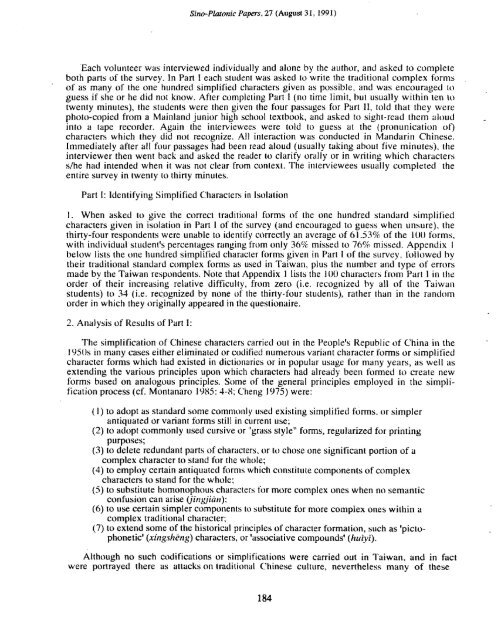Essays on Writing and Language in Honor - Sino-Platonic Papers
Essays on Writing and Language in Honor - Sino-Platonic Papers
Essays on Writing and Language in Honor - Sino-Platonic Papers
Create successful ePaper yourself
Turn your PDF publications into a flip-book with our unique Google optimized e-Paper software.
S<strong>in</strong>o-Platnnic <strong>Papers</strong>, 27 (Aupt 3 1, 199 1)<br />
Each volunteer was <strong>in</strong>terviewed <strong>in</strong>dividually <strong>and</strong> al<strong>on</strong>e by the author, <strong>and</strong> asked to complete<br />
both parts of the survey. In Pan I each student was asked to write the traditi<strong>on</strong>al complex forms<br />
of as many of the <strong>on</strong>e hundred simplified characters given as possible. <strong>and</strong> was encouraged to<br />
guess if she or he did not know. After complet<strong>in</strong>g Part I (no time limit. hut usually with<strong>in</strong> ten to<br />
twenty m<strong>in</strong>utes), the students were then given the four passages for Part 11, told that they were<br />
photo-copied from a Ma<strong>in</strong>l<strong>and</strong> junior high school textbook, <strong>and</strong> asked to sight-read them aloud<br />
<strong>in</strong>to a tape recorder. Aga<strong>in</strong> the <strong>in</strong>terviewees were told to guess at the (pr<strong>on</strong>unicati<strong>on</strong> ot)<br />
characters which they did not recognize. All <strong>in</strong>teracti<strong>on</strong> was c<strong>on</strong>ducted <strong>in</strong> M<strong>and</strong>ar<strong>in</strong> Ch<strong>in</strong>ese.<br />
Immediately after all four passages had been read aloud (usually tak<strong>in</strong>g about five m<strong>in</strong>utes). the<br />
Interviewer then went back <strong>and</strong> asked the reader to clarify orally or <strong>in</strong> writ<strong>in</strong>g which characters<br />
s/he had <strong>in</strong>tended when it was not clear from c<strong>on</strong>text. The <strong>in</strong>terviewees usually completed the<br />
entire survey <strong>in</strong> twenty to thirty m<strong>in</strong>utes.<br />
Part I: Identify<strong>in</strong>g Simplified Characters <strong>in</strong> Isolati<strong>on</strong><br />
1. When asked to give the correct traditi<strong>on</strong>al forms of the <strong>on</strong>e hundred st<strong>and</strong>ard s<strong>in</strong>lplified<br />
characters given <strong>in</strong> isolati<strong>on</strong> <strong>in</strong> Part 1 of the survey (<strong>and</strong> encouraged to guess when unsure), the<br />
thirty-four resp<strong>on</strong>dents were unable to identify correctly an average of 61.53% of the 10U forms,<br />
with <strong>in</strong>dividual student's percentages rang<strong>in</strong>g from <strong>on</strong>ly 36% missed to 76% missed. Appendix 1<br />
below lists the <strong>on</strong>e hundred simplified character forms given <strong>in</strong> Part I of the survey, followed by<br />
their traditi<strong>on</strong>al st<strong>and</strong>ard complex forms as used <strong>in</strong> Taiwan, plus the number <strong>and</strong> type of errors<br />
made by the Taiwan resp<strong>on</strong>dents. Note that Appendix 3 lists the 1OO characters from Part I <strong>in</strong> the<br />
order of their <strong>in</strong>creas<strong>in</strong>g relative difficulty, from zero (i.e. recognized by all of the Taiwan<br />
students) to 34 (i.e. rec.ognized by n<strong>on</strong>e of the thirty-four students), rather than <strong>in</strong> the r<strong>and</strong>om<br />
order <strong>in</strong> which they orig<strong>in</strong>ally appeared <strong>in</strong> the quesli<strong>on</strong>aire.<br />
2. Analysis of Results of Part 1:<br />
The simplificati<strong>on</strong> of Ch<strong>in</strong>ese characters carried out <strong>in</strong> the People's Republic of Ch<strong>in</strong>a <strong>in</strong> the<br />
1 950s <strong>in</strong> many cases either elim<strong>in</strong>ated or codified numerous variant character forms or simplified<br />
character forms which bad existed <strong>in</strong> dicti<strong>on</strong>aries or <strong>in</strong> popular usage for many years, as well as<br />
extend<strong>in</strong>g the various pr<strong>in</strong>ciples up<strong>on</strong> which characters had already been formed to create new<br />
forms based <strong>on</strong> analogous pr<strong>in</strong>ciples. Some of the general pr<strong>in</strong>ciples employed <strong>in</strong> the simpli-<br />
ficati<strong>on</strong> process (cf. M<strong>on</strong>tanaro 1985: 4-8: Cl~eng 1975) were:<br />
( 1 ) to adopt as st<strong>and</strong>ard some comni<strong>on</strong>l y used exist<strong>in</strong>g simplified forms. or simpler<br />
antiquated or variant forms still <strong>in</strong> current use;<br />
(2) to adopt comm<strong>on</strong>ly used cursive or "grass style1' forms, regularized for pr<strong>in</strong>t<strong>in</strong>g<br />
purposes;<br />
(3) to delete redundant parts of characters. or to chose <strong>on</strong>e significant porti<strong>on</strong> of a<br />
complex character to st<strong>and</strong> for the whole;<br />
(4) to employ certa<strong>in</strong> antiquated forms which c<strong>on</strong>stitute comp<strong>on</strong>ents of complex<br />
characters to st<strong>and</strong> for the whole;<br />
(5) to substitute hom<strong>on</strong>ophous characters for more complex <strong>on</strong>es when no semantic<br />
c<strong>on</strong>fusi<strong>on</strong> can arise (jir~~ibrir<strong>in</strong>):<br />
(6) to use certa<strong>in</strong> simpler comp<strong>on</strong>ents to substitute for more complex <strong>on</strong>es with<strong>in</strong> a<br />
complex traditi<strong>on</strong>al character:<br />
(7) to extend some of the historical pr<strong>in</strong>ciples of character formati<strong>on</strong>, such as 'picto-<br />
ph<strong>on</strong>etic' (x<strong>in</strong>gshPng) characters, or 'associative compounds' (huiyi).<br />
Although no such codificati<strong>on</strong>s or simplificati<strong>on</strong>s were carried out <strong>in</strong> Taiwan, <strong>and</strong> <strong>in</strong> fact<br />
were portrayed there as attacks <strong>on</strong> traditi<strong>on</strong>al Ch<strong>in</strong>ese culture, nevertheless many of these

















